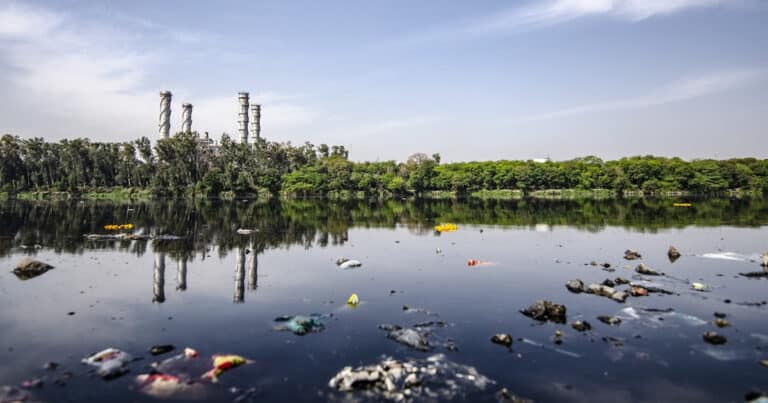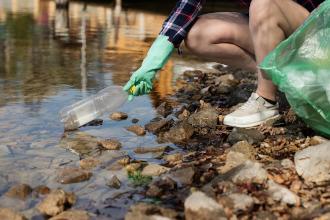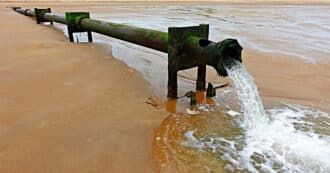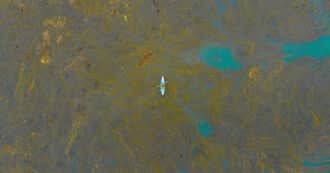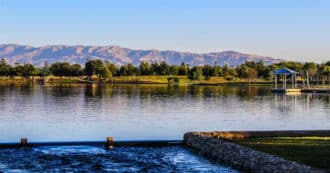By Sydney Cohen – Water contamination, by “substances which make the water unusable for drinking, cooking, cleaning, swimming, and other activities,” is termed water pollution. Water pollution has many extremely harmful effects on humans, as well as ecosystems, animals, marine life, and plant life that utilize these contaminated water sources. So, what are the causes of water pollution?
The causes of water pollution are most frequently trash, bacteria, parasites, and chemicals. These various pollutants affect water quality and can cause many problems for us such as disease outbreaks and dead zones where nothing can live due to lack of oxygen in those areas.
Water pollution is a serious issue. The EPA reports that one-third of the rivers and streams in America are too polluted to support aquatic life, making it unsafe for humans to drink from as well. And yet water pollution continues to be an issue. What are the causes of water pollution?
Causes of Water Pollution
The first cause of water pollution is runoff due to the improper disposal of chemicals or fertilizers on land near waterways. These chemicals often end up downstream where they contaminate drinking water sources like lakes and reservoirs. Pollutants from the air can settle on the surface of oceans and lakes, and seep into the water and the underground aquifers. Pollutants from the land can make their way into underground streams, rivers, and then to oceans. While specific pollutants can vary in their origin, all forms of pollution eventually make their way into all of the Earth’s bodies of water.
Human waste is also another main factor in water pollution. Sewage is a major contributor to global water pollution because it often contains both bacteria and chemicals that contaminate the local ecosystem when they enter rivers or other bodies of water during heavy rainstorms.
Septic systems also contribute to water pollution because they release untreated wastewater into the ground near residential areas where it eventually reaches nearby waterways through runoff. This type of contamination is harmful for humans as well because people may unknowingly consume polluted water supply.
Categories of Water Pollution
Groundwater Pollution
The first category of water pollution is in groundwater. Groundwater results from fallen rain that soaks into the earth and fills cracks and crevices underground. It is then pumped to the surface to be used and consumed. Rural areas often rely on groundwater as their only freshwater source. When pesticides, fertilizers, and toxic chemicals from septic systems and landfills seep into these deeper water sources, the groundwater becomes contaminated.
It is incredibly costly and difficult to purify groundwater of pollutants, and contaminated groundwater can spread its pollution to other bodies of water such as streams, oceans, and lakes, far from the original source of pollution.
Surface Water Pollution
The next category of water pollution is in surface water. Surface water is what the earth’s oceans, rivers, and lakes consist of. Nutrient pollution, primarily resulting from toxic chemicals such as nitrates and phosphates, is the main contributor to contamination in these water sources.
While these contaminants do prove helpful to the growth of plants and animals, excess of them can have harmful consequences to ecosystems and the humans using these water sources. Nutrient pollution most frequently results from agricultural fertilizer runoff and farm waste.
Ocean Pollution
The last category of water pollution takes place in our ocean water. The majority of ocean pollution comes from land. Rivers and streams carry contaminants – nutrients, chemicals, and heavy metals – from agricultural farms, cities, and factories into bays, where they then make their way into our oceans.
Additionally, oceans are also affected by plastics and debris that are both blown by the wind and carried, much like the pollutants, through drains and sewers into the ocean. Lastly, oceans are also affected by oil spills and leaks, no matter their size, and are regularly absorbing carbon emissions from pollution in the air.
Water Pollution is Transboundary
Water has no need of a passport to cross borders!
What furthers the issue of water pollution across the globe is that it is transboundary, meaning that because of the connection between so many of the world’s bodies of water, it is difficult to trace the source of water pollution. The fact that countries share water sources has led to severe disputes, and even wars, when one country pollutes another country’s water sources.
This also means that it is a global issue, affecting everyone on earth at varying levels. Water pollution can be point source or nonpoint source, meaning the origin of a certain pollutant is either traceable or results from the culmination of multiple contaminants.
Point source pollution allows for governmental regulations on corporations that utilize potentially harmful contaminants. However, “nonpoint source pollution is the leading cause of water pollution in US waters,” which proves difficult to regulate, as there is no traceable source.
The Most Common Types of Contamination
Agriculture
As previously touched upon, water pollution is most frequently caused by agricultural runoff, sewage and wastewater, heavy metals and toxic chemicals, oil pollution, and radioactive substances.
When it rains, contaminants from the agricultural sector (farms and livestock operations) flow into all of our waterways. These pollutants consist of pesticides, fertilizers, and animal waste, as well as bacteria, viruses, and parasites. Additionally, nutrient pollution from nitrates and phosphates in the air and water create harmful effects on the environment.
Sewage
Next, sewage and wastewater from our toilets, showers, and sinks, as well as from industrial, commercial, and agricultural enterprises contribute to global water pollution. Often, this is from stormwater runoff, caused by rain that carries chemicals, grease, oil, debris, and road salts into our waterways.
Industry
Another main contributor to water pollution is industrial waste such as oil, not just resulting from deep-sea oil spills and leaks, but the constant usage of gasoline in cars and vehicles, and land-based industrial factories, cities, and farms.
Additionally, another industrial waste is radioactive waste, “generated by uranium mining, nuclear power plants, and the production and testing of military weapons, as well as by universities and hospitals that use radioactive materials for research and medicine,” which is incredibly difficult and costly to dispose of, and is often accidentally released into marine resources, surface water, and groundwater.
Solid Waste
Lastly, but the easiest to prevent, is human dumping of garbage and litter is extremely harmful to our water sources across the world. The Ocean Conservatory reported that “every year, 8 million metric tons of plastics enter our ocean on top of the estimated 150 million metric tons that currently circulate our marine environments.”
As one can imagine, thoughtless dumping of trash is incredibly detrimental to our marine life. Often, plants and animals become trapped in plastics and other debris, resulting in injury, health and reproductive issues, and death.
Global Warming and Water Pollution
Global warming is also a large factor affecting water pollution across the world. Increased air pollution, as we’ve witnessed over the past century, has caused excess carbon dioxide, lead, nitrogen dioxide, ozone, particles, and sulfur dioxide, in the air from industrialization.
Our oceans are able to absorb carbon dioxide from the air, which results in the warming, expansion, and acidification of these bodies of water across our earth, which has a direct impact on marine water quality.
The increasing temperature has caused the oceans to warm and expand while simultaneously decreasing the amount of oxygen that can be dissolved in water. This change has led to an increase in oceanic dead zones, which are areas where there is not enough oxygen for marine life to survive.
Because of global warming caused by increased pollution, marine life and marine ecosystems and environments are particularly vulnerable to harm as their environment changes.
Our Bible Teaches us to Appreciate Clean Water
Valuing Water is described in greater detail in Eco Bible: Volume One: An Ecological Commentary on Genesis and Exodus: Deuteronomy 2:6 – “What food you eat you shall obtain from them for money; even the water you drink you shall procure from them for money.” This verse states that the Israelites were to buy water from the inhabitants when they passed through the land of Seir, in today’s Jordan.
Elsewhere in the Torah, water is free, especially in the desert when, according to the Midrash, Miriam’s well freely provides water for 40 years. Today, an important aspect of Israel’s water policy is to charge a “market price” for water, not a subsidized price as seen in many nations. This encourages people to conserve water appropriately, and allows for increasing the price during a drought.
A story about Rabbi Yisroel Salanter in Paris describes him waiting in a fancy hotel for a potential donor to his Torah academy. He orders a glass of water, and when the bill comes, he’s shocked at the cost. Rabbi Salanter summons the waiter and asks him if they had made a mistake over the charge for a simple glass of water.
The waiter, somewhat embarrassed, explains that the charge also includes the ambience, the beautiful building, the expensive furnishings, the expansive gardens surrounding him and the attentive care of the waiters. At this point, Rabbi Salanter thanks the waiter profusely and pays willingly.
Afterwards, he explains to his students that he learned from the waiter the answer to an important question. Why do we recite the blessing before drinking a simple glass of water (“Blessed are You, God … that everything exists by God’s word”)? After all, water is the simplest thing we can drink. Why thank God for everything in the Universe? The waiter’s answer helped him appreciate that we are all in God’s luxury hotel.
When we drink a simple sip of water, we must realize that we are getting far more than pure refreshment. We have solid ground beneath our feet, plentiful fresh air, a beautiful sky, the smell of flowers, the chirping of birds and all the beauty and conveniences of creation. When we take a sip of water, we should remember, not only do we owe God a thank you for the water, but also for the ambience of the Creator’s luxurious world.
In that world, nature cleanses water, which economists quantify as an “ecosystem service.’” New York City has spent $1.5 billion in protecting over 108,000 acres of land in the Hudson River watershed, rather than build expensive drinking water treatment facilities. By letting nature do the work, it saves significant costs and reduces energy use. This program is one of the most comprehensive in the world.
We think of water as our most basic resource, but today over 40% of the global population do not have access to safe drinking water. If we start to value water, like the Bible teaches us to, then we will not cause pollution of our most vital resource.
* Featured image source

